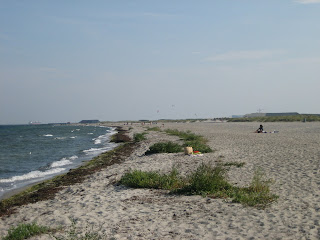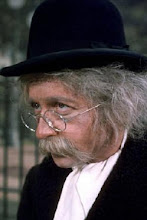(A brief digression about my Copenhagen vacation as people (well two people) have been asking about it)
As usual, I began this blog post a while ago and started immediately overwriting. After several hundred words I decided to chuck the whole thing and just post some of my pictures and add some comments.
By law any discussion of Copenhagen must include the statue of The Little Mermaid. It is one of the iconic vacation attractions - something that whenever you say you went to a city, someone asks "did you go see such-and-such?" There were at least eight tour buses parked near the statue, with dozens of people surrounding it taking pictures of every conceivable angle. Some facts about the statue:
- This is actually a copy. The original statue is in the possession of the heirs of the sculptor (Edvard Eriksen), stored in an undisclosed location.
- There are authorized copies of the statue all over the world. Anyone attempting to display an unauthorized copy will be sued.
- The statue has been in the same location for almost a century except for one 10-month period when it was sent to be part of the Danish exposition at the Shanghai World Expo.
The city of Copenhagen is located on two islands and has a number of canals. I highly recommend taking a boat tour. It gives you a good overview of the city and points out places you can visit on foot later.
Copenhagen reminds me a bit of Amsterdam, but the buildings aren't as narrow or colorful.
While the canals are still used for transportation in the city, some of
the bridges are so low that only very small boats can go under them
This is the old Copenhagen Stock Exchange (the Børsen). It was built in the early 1600's and housed the exchange until the 1970's
The building's most notable feature is the Dragon Spire Tower, made from the intertwined tails of four dragons.
Copenhagen has built a lot of their newer buildings along the narrow strait of water that separates the two islands. This is the Copenhagen National Opera House
The Royal Danish Playhouse
The Royal Danish Library, also known as the Black Diamond
This is a old waterfront warehouse that was converted into an apartment block
The Danish Royal Yacht: Dannebrog. While it doesn't look that impressive, there are three levels below the waterline. The royal family lives above the waterline, the crew and all the equipment stay below.
The center of Copenhagen is filled with twisty roads. This is by design - in case of invasion the enemy couldn't shoot from one end of the street to the other
There are a lot of pedestrian-only sections of the city center. This is Hochbrucke Plads (Square).
This is Højbro Plads. The statue is of Absalon, the Danish warrior-bishop who is considered the founder of Copenhagen.
These elephant statues were all over Copenhagen. They are part of an international outdoor exhibit run by The Elephant Parade to raise money for the preservation of the Asian elephants.
There is a lot of street food in Copenhagen, but most of the vendors
work out of storefront counter that face out from full restaurants. The
stand-alone carts mostly sell hotdogs. There are multiple varieties of
them (beef, pork, veal, etc.) and you can by them wrapped in dough or as
is served on a tray with mustard.
There are castles or slots scattered around the city. Originally built as residences for the royal family, most have been turned over to the Danish government. Above is the Christiansborg Castle, now the home of Danish Parliament and Supreme Court
This is the Frederiksberg Slot. Originally built as the royal family's summer residence, it now houses the Royal Danish Army Officers Academy. The tower to the right is part of the Copenhagen Zoo.
The slot is part of Frederiksberg Park, one of the largest and most attractive greenspaces in Copenhagen.
This is a tree with hundred of baby pacifiers hanging from its branches. It confused the hell out of me when I first saw it. I have since learned that when a child grows old enough to give up their pacifier it is the custom to take it to this tree and leave it there.
This is City Hall Square. A lot of public events are held here. The first night I was in Copenhagen there was a concert to mark the end of Danish Gay Pride weekend. When I was leaving they were setting up outdoor basketball courts for a tournament.
Copenhagen City Hall
This building kitty-corners on City Hall Square. It has three interesting features:
- There is a figure holding a bicycle at the top.
- The corner is a thermometer.
- The Carlsberg logo on the building reads "Probably the Best Beer in Town". There were a number of ads in Copenhagen where "probably" was used. This might be to avoid lawsuits.
Tivoli Gardens is the Disneyland of Copenhagen (Walt Disney was actually inspired by Tivoli when he was building his park). It was built in the 1840’s as a way to amuse the public during a time of political unrest. It is known for amusement rides, performance venues and restaurants. It costs 75 to 95 DKK (about $15 to $19) just to enter the park. Rides are extra and the restaurants are on the expensive side. Most of the performances are free. The younger you are, the more you will appreciate the place.
The Pantomime Theater
Tivoli's Moorish Palace, which contains the Nimb Hotel and Restaurant.
Big band jazz performance with the Dæmonen roller coaster in the background.
These are the three most impressive rides in Tivoli. They are the tallest objects in the city center and can be used as landmarks when wandering the streets.
Tivoli closes most nights at 10:00 PM, so there are a lot of lights along the walkways
A statue of Pierrot or Pjerrot - a stock character of the pantomime plays that are performed regularly at Tivoli.
While we were in Copenhagen the Danish Prime minister called for parliamentary elections. The next day bands of political party workers were out covering everything they could find with candidate posters.
Denmark has its share of politicians who are finks too. Notice the style of the poster above it. All the candidates of that party had black and white, partial face posters.
Vor Frelsers Kirke (The Church of our Savior). Located in the Christianshavn district the church's the main attraction is the golden spire. 90 meters high, it is open to the public and the last third of the climb is a spiral staircase on the outside of the building.
Views from the top of the spire
This is another view of the Church of Our Savior rising over the outer wall of Christiania. Christiania is a kind of commune where free-thinkers and outcasts live together. It was founded by squatters who took over deserted military buildings during a housing shortage. It is also an area known for the open sale of marijuana in its “Green Light District”. The district has three rules:
- Have fun
- Don’t run (implies that someone - the law - is chasing you)
- No cameras (see #2)
This is the original Amager Beach Park located about 5 kilometers from the center of Copenhagen. It was not considered a very good beach due to it's shallowness and poor water quality. To improve its condition, Denmark built an artificial island front of it designed to fix those problems.
Amager Beach Park is now considerd a "Blue Flag" beach - indicating top notch quality with regard to the environment, security, facilities and information.
I had to take a picture of this sand sculpture because of the effort someone put into making it. It is life-sized. The hair and tail are seaweed. The bra is small clam shells. The belt is muscle shells. There is also a wrist-watch made from pebbles.
Off in the distance in this picture you can see the Øresund Bridge, which connects Copenhagen with Malmo, Sweden. It is the longest road and rail bridge in Europe.
Also visible from the beach are the offshore wind farms. Wind power accounts for over 22% of Copenhagen's electricity consumption. The plan is to increase the number of wind turbines to provide 50%.
General Comments About Copenhagen
You don't have to sign a customs declaration form when you land at Copenhagen Airport.
Beer is everywhere. There are no open container laws so people walk around with cans and bottles of Carlsberg and Tuborg all day long.
Surprisingly the most common US business is 7-11. They are on almost every busy intersection in the city. Naturally they sell danish snack food rather than taquitos and nachos. Of course beer is in every store.
All public transportation (bus, metro, commuter rail) is considered a single entity. To get from point A to point B you pay for the number of zones you will go through. The ticket is good for an hour and you can use any combination of transportation you want.
The Danes are into hooks. They are all over the walls and under tables (for umbrellas). Subsequently almost everything sold in Denmark has a loop on it so it can hang.
While there are not many cars in the city center there are plenty of bicycles. You can easily come across a parking area filled with hundreds of bikes. There are supposed to be bike lanes, but bikers will go wherever they feel they have to.
In addition to bikes there are pedi-cabs. The people who drive these cabs are the same as cabdrivers in the heart of NYC. Keep your eyes and ears open when walking Copenhagen streets.
The restaurants in the city center are a combination of touristy places and immigrant-owned businesses. The most popular food on the streets are pizza, shawama, “China boxes”, crepes, waffles, and Indian. Those restaurants not located on the main pedestrian streets have people holding signs with dinner specials and directions to their shops.
As with most of Europe there is a lot of smoking in Copenhagen - pretty much all done outside. While Copenhagen does a great job keeping the streets clean of general litter, there are cigarette butts everywhere.
Movies houses sell reserved seats like theaters - there are even price differentials depending on where you sit.
Danish bakers are fantastic. Their pasties and breads are among the best I have ever eaten.
A Danish sandwich is a work of art.
Danish dragons have belly buttons.













































